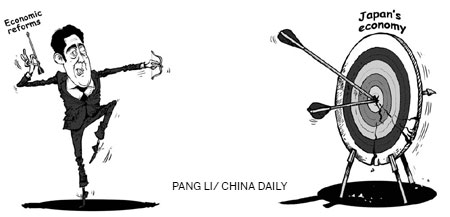The gamble that is Abenomics
Updated: 2013-06-07 08:13
By Xu Changwen (China Daily)
|
||||||||

After being sworn in as prime minister at the end of 2012, Abe introduced "Abenomics" in an attempt to tide over the country's economic troubles. Abenomics includes "three arrows": quantitative easing, positive fiscal policies to stimulate demand and creation of sustainable growth.
The first two arrows, the depreciation of Japanese yen and a 2 percent rise in consumer prices index, have already been shot. The exchange ratio of the US dollar against yen increased from 1:80 to 1:101.52 on May 24, and then fell to 1:99.95 on June 5. Last year, the International Monetary Fund set the ratio at 1:100.47, while the Organization for Economic Cooperation and Development insisted that 1:103.9 was a more realistic ratio. So the ratio is close to Western economists' estimate.
The primary reason for the depreciation of the yen is the huge supply of banknotes. According to Bank of Japan data, the supply of money in the country will increase by 132 trillion yen to 270 trillion yen by the end of 2014.
The immediate impact of the yen's depreciation has been the increase in the value of some Asian countries' currencies against the yen. For example, the value of the Chinese yuan against the yen has increased by 18.5 percent. Likewise, the Indian rupee has risen by 17.12 percent, the Republic of Korea's won by 10.88 percent and the Thai baht by 20.17 percent.
This development may curb the economic recovery of these countries. Since more than 50 percent of the trade between these countries and Japan is settled in the Japanese currency, its depreciation has caused a decline in Japanese investment in these countries. Also, their exports have declined. For example, the ROK, one of Japan's main competitors, has seen a fall in the export of its oil products, automobiles and mechanical products.
The stock and debt markets of these countries, too, may come under pressure, because fears of the yen depreciating further could force more international short-term capital to flood their markets. That would not only cause their stock and debt prices to fluctuate, but also could lead to inflation.
The depreciation of the yen has had a negative impact on Japan too, and the country could enter a vicious circle of currency depreciation. Japan's trade deficit has been rising continuously. In 2011, it had a trade deficit of $32.28 billion for the first time in decades. The figure has increased to $87.11 billion last year, and the trade deficit could force Japan to increase its fuel imports, which, in turn, could lead to further depreciation of the yen.
Related readings:
A weak currency for Japan is not the full answer
Japan disaster money spent on counting turtles
Japan politicians seek to mend ties
Risky Abenomics
Full picture of 'Abenomics' unveiled

 Michelle lays roses at site along Berlin Wall
Michelle lays roses at site along Berlin Wall
 Historic space lecture in Tiangong-1 commences
Historic space lecture in Tiangong-1 commences
 'Sopranos' Star James Gandolfini dead at 51
'Sopranos' Star James Gandolfini dead at 51
 UN: Number of refugees hits 18-year high
UN: Number of refugees hits 18-year high
 Slide: Jet exercises from aircraft carrier
Slide: Jet exercises from aircraft carrier
 Talks establish fishery hotline
Talks establish fishery hotline
 Foreign buyers eye Chinese drones
Foreign buyers eye Chinese drones
 UN chief hails China's peacekeepers
UN chief hails China's peacekeepers
Most Viewed
Editor's Picks

|

|

|

|

|

|
Today's Top News
Shenzhou X astronaut gives lecture today
US told to reassess duties on Chinese paper
Chinese seek greater share of satellite market
Russia rejects Obama's nuke cut proposal
US immigration bill sees Senate breakthrough
Brazilian cities revoke fare hikes
Moody's warns on China's local govt debt
Air quality in major cities drops in May
US Weekly

|

|







